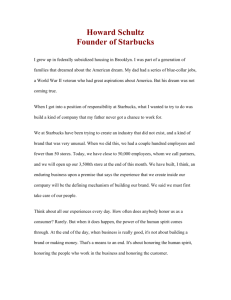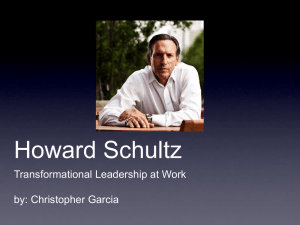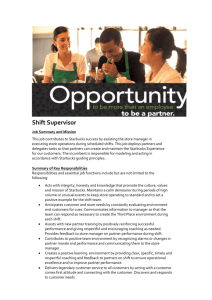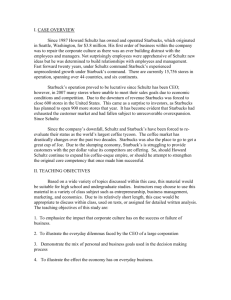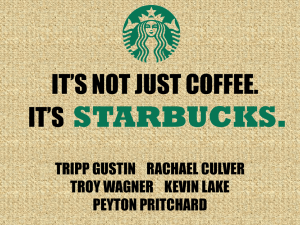File
advertisement
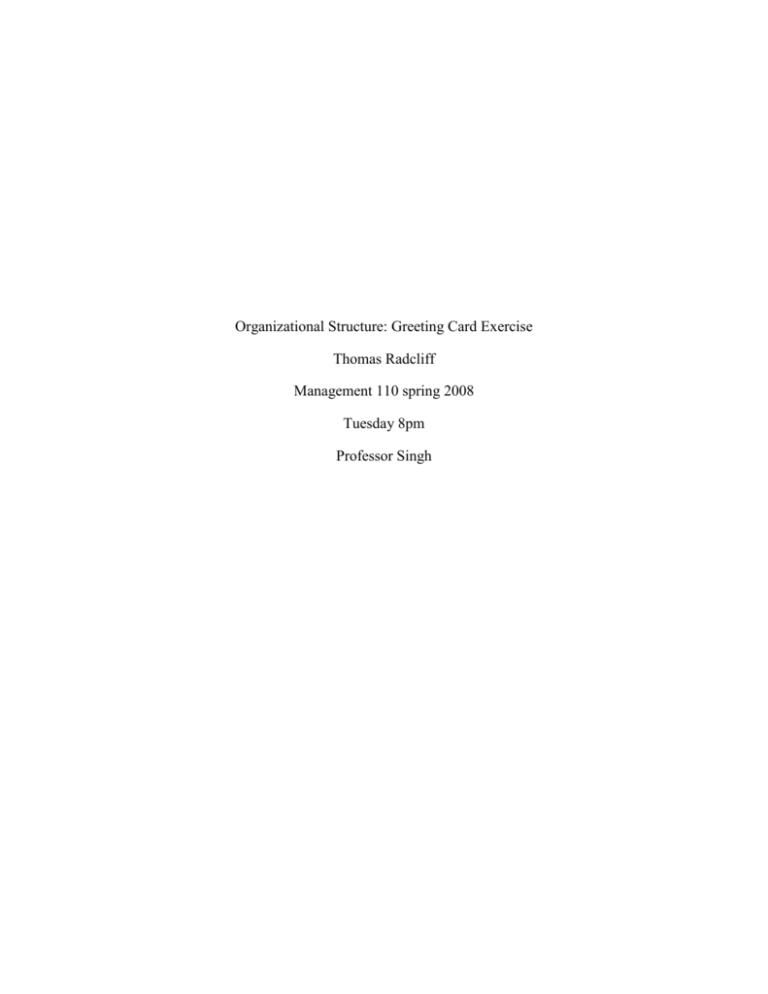
Organizational Structure: Greeting Card Exercise Thomas Radcliff Management 110 spring 2008 Tuesday 8pm Professor Singh Introduction: As defined in our text book, “organizational structure refers to the formal system of work roles and authority relationships that govern how associates and managers interact with one another” (Hitt, Miller, & Colella, 2006,p.480). Organizational Structure should be evaluated from time to time to assure performance and efficiency. Whether you own a premium coffee company or you are working in small groups in a class room, organizational structure will determine your success against competition. In lab, we were asked to be put into specific organizational structures based on what instructions our CEO received from the instructor. The groups were put into several different types of organizations and were given instructions to create three different types of greeting cards. The team with the most greeting cards in the allotted amount of time won. Members in the groups were asked to be categorized by our best ability of creativeness, penmanship and grammar and spell checking. After our first trial run of making cards we realized our organizational structure disabled us to compete with other groups in our class. In the article from BusinessWeek titled “Howard Schultz on Reinventing Starbucks,” Starbucks founder Howard Schultz regained his position as CEO after eight years in order to reestablish Starbucks’ reputation as the premium coffee of the world. Greeting Card Exercise: This exercise required that the class get into two groups of eleven. After getting into our groups we had to elect a CEO and a production manager. The CEO and production manager received specific instructions from the instructor on how to organize their groups. Our CEO asked us to categorize ourselves based on our ability to be creative, our penmanship and our editing skills. Our organizational structure was similar to the departmentation style of the Simplified Functional Organization, while the other group used a Simplified Divisional Organizational structure. Departmentation is referred to as the, “grouping of human and other resources into units based on the same or similar functional areas or markets” (Hitt, Miller, & Colella, 2006,p.483). Our first department consisted of three creators who wrote down certain rhymes and versus for the greeting cards. After completing the creative process, the card was then walked over to someone in the penmanship department. The card was read aloud and the penmanship department associate wrote down what was being said very carefully. After leaving the penmanship department, the card got moved to the editing department where grammar and punctuation and spelling errors were fixed. The final step was for the production manager to hand the finalized greeting card to the instructor. After completing three different trials, the class figured out why certain groups were being successful and why others were not. Our group’s organizational structure was set up for us to fail. The reason for this was because our group was forced to be isolated based off our structure. Our departmentation structure forced us into three different departments which forced us to coordinate only within our groups and not departments. Not being able to coordinate our actions with each department lead to the result of a very slow production rate. The group that had an organizational structure of a Simplified Divisional Organization beat other groups by more than half every time. The advantages that this particular group had were coordination between divisions, response times and adapting to change in the type of card we were assigned to make. Using the divisional structure, the group that won had divisions consisting of one or more creators, one penmanship associate and one editor. This allowed the card to be moved to the production manager faster because there was more coordination between the three types of associates. This particular group also had an advantage because our “industry” was being changed every five minutes, allowing the group to tailor to the product faster causing a faster production rate. In comparison of organizational structure, the BusinessWeek article titled “Howard Schultz on Reinventing Starbucks”, Howard Schultz realized that as his company was getting bigger they were getting “a little out of balance” (Schultz, 2008). Brief Summary of the Article: In the article, “Howard Schultz on Reinventing Starbucks”, founder and recently 2nd termed CEO Howard Schultz expresses how he is going to “reinvent brewed coffee across America” (Schultz, 2008). Schultz plans to focus on putting Starbucks’ feet in the shoes of their customers and look at what they are experiencing at its stores. Schultz mentions Pike Place Roast, as the start of this new generation Starbucks. Pike Place Roast is Starbucks’ newest brewed coffee and serves the purpose for an “everyday coffee for everyman.” Schultz realized that the company needed new and exicting inovation and “relentless customer focus” to get back into the market (Schultz, 2008). In the interview, Schutlz was asked if it’s hard to make a company grow if they are already as big as Starbucks. Schultz’s answer to the question was phenominal, understanding that as a company, you can grow and still be small. Schutlz realized that Starbucks is growing and that the company needed a balance between four ingredients: creativity, entrepreneruship, process and strategy. Schutlz is internally focused as well. He is infusing the company with spirit and inovation; which they once had when the company was smaller. Schultz’s awareness of his company allows Starbucks to adapt to changes in the market. Regardless of Starbucks’ new inovations and regaining it’s balance, it still faces a tough market with the economy in a regression. For example, Starbucks research shows that its customers are not buying coffee elsewhere but they just are not buying their coffee as frequently. Schutlz believes that even in a bad economy customers can still enjoy the luxury of a Starbucks coffee. The introduction of the new brew, Pike Place Roast, is just the beginning of the new reinvented Starbucks for America. Connecting the Greeting Card Excerise to Reinventing Starbucks: The connection between Starbucks and the greeting card exercise revolves around organizational structure. As our group experienced a departmentation structure, we encountered similar problems like Starbucks. Our group exercise relates to Starbucks because we realized that our organizational structure did not work effiecently because of the size of our group and the way our group was organized. Starbucks was faced with the same understanding that working in small groups creates greater effiency. Starbucks was not in trouble because they were not producing coffee beans fast enough as competitors like our group was in the greeting card exercise, but Starbucks was faced with some disorganization within their company. Schultz saw the downfall of how his company was structured and it was causing the company to be less creative and entrepreneurial. Schultz’s new organizational structure is going to be focused more towards being a Simplified Divisional Organizational structure. With a more Simplified Divisional Organizational structure, Starbucks will be focused on trying to be more condensed and compact to work on creativity and entreprenurialship skills. In an ever changing market, by moving to a Simplified Divisional Organizational structure, Starbucks can tailor their products like the Pike Place Roast, because of the benefits that come from this type of organizational structure. In lab, we had to tailor our greeting cards every five minutes and being set up in a departmental style of the simplified organzational structure did not allow us to adapt to changes. This was obvious for Howard Schultz as well; he knew that Starbucks needed new products and his organzation had become too big in order for them to focus on things like inovation and creativity. How the Article Relates To the Text: The article directly relates to the text by two different terms. The first being departmentation, which is defined as, “the grouping of human and other resources into units, typically based on the same type of functional areas” (Hitt, Miller, & Colella, 2006, p.483). Schultz said that his company had become too big and out of balance which was caused by the structure of the organization. A Starbucks got bigger, they were not as focused on their inovations and creativity because their organizational functions where their primary focus. This explanation can be directly related to the departmentation style of organizational structure. The second term is Simplified Divisional Organization, which is when, “an organization has multiple products or services, and groups its resources into divisions” (Hitt, Miller, & Colella, 2006,p.484). This was the solution to Starbucks. Schultz felt that Starbucks lost their original touch because the company had become too big. By understanding that a company can become big and stay small, Schultz is focusing the organizational structure on a Simplified Divisional structure to enhance their creativity, inovation and customer focus. Conclusion: As we learned in lab, organizational structure can extreamly hinder an organization if implemented incorrectly. Companies that are just starting out may not need to be focused on whether or not their organizational structure is benefiting the business, but as they expand and grow like Starbucks, they need to be aware of their company’s efficency in order to be successful. Reference Page Hitt, M. A., Miller, C. C., & Colella, A. (2006). Organizational Behavior. Hoboken: John Wiley & Sons, Inc. Schultz, H. (2008, April 9). Howard Shultz on Reinventing Starbucks. (M. Bartiromo, Interviewer)
